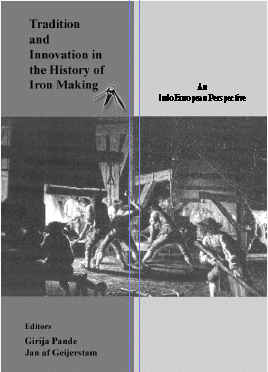SWEDISH SOUTH ASIAN STUDIES NETWORK
Tradition and Innovation in the History of Iron Making. An Indo European Perspective
 New
book edited by Girija Pande, Dept. of History, University of Kumaon, India;
and Jan af Geijerstam, Dept. of the History of Science & Technology,
Royal Institute of Technology, Stockholm.
New
book edited by Girija Pande, Dept. of History, University of Kumaon, India;
and Jan af Geijerstam, Dept. of the History of Science & Technology,
Royal Institute of Technology, Stockholm.
On 31 March 2003, a new book on the history of iron, from
ancient times to the late twentieth century was released at the International
Centre in New Delhi. The volume is the result a joint venture between
Indian and Swedish scholars. In the foreword Savyasachi Bhattacharya,
Prof. of Economic History at Jawaharlal Nehru University, JNU, New Delhi,
writes:
”This book examines an issue, which lies at the core of the history
of economic development. What makes a transition from traditional techniques
to modern technology difficult in some societies and easier in other ones?”
ISBN: 81–86246–19–3
Price: Rs. 1 000 (in India), US$ 60 (outside India,
including postage)
Published by PAHAR, Parikrama, Talla Danda, Nainital–263002,
Uttaranchal, INDIA,
Phone: +91–5942–236191, 239162,
E–mail: parikramavaasi@hotmail.com.
Presentation: This volume examines an issue
which lies at the core of history of economic development. It includes
within its ambit not only the process of iron making in India and Sweden,
but has taken into account the broad trends prevailing elsewhere in the
world. The special feature of this volume is that the inception and progress
of iron technology is seen in its entirety, i.e. starting from ancient
to colonial period and onwards. The volume is an unusual inter–disciplinary
exercise in which scholars of different background presented their ideas
on a specific research area.
The essays in this volume are organized in five different sections. Each
section has its own speciality and together they present a coherent picture
of iron making in history. The first section Ancient Iron and
Steel and the Inception of new Technologies looks into the development
of ancient method of iron making in India and Sweden and also various
theories associated with this phase. The second section Interdependence
and Change on the Verge of Industrialism has taken in its fold
a number of issues related to the policy making in the manufacturing of
iron. The third section Traditional Iron Making: Transition and
Survival, takes into account the different traditional iron making
practices prevailing in different parts of India and Sweden and how it
encountered the changes at political and administrative levels. The forth
section Twentieth Centuries Change and Restructuring deals with the chronological
developments in the realm of iron technology and how both countries incorporated
these developments at different levels of the production process The last
section Sweden & Kumaon: An Introduction in Historical Context
introduces the reader with two different geopolitical settings, Sweden
and Kumaon, their historical, socio–economic, geographical as well
as the cultural background.
Contents:
Foreword – Savyasachi Bhattacharya
Preface – Girija Pande & Jan af Geijerstam
Illustrations
Introduction – M. Kumar & Deepak Kumar
Section I:
∑ Outstanding Problems of Early Iron Age in India – D.P.Agrawal & J.S.Kharakwal
∑ The Inception of Iron and Steel Making in India – Bhanu Prakash
∑ Iron and Steel in Ancient India – Friedrich Toussaint
∑ Some Aspects of Iron Making in Antiquity vis–a–vis Central Himalaya – M.P.Joshi
∑ The Inception of Iron Production in Sweden and the Development during the First Two Millennium – Gert Magnusson
Section II:
∑ Interdependent Development – British and Swedish Iron making – Chris Evans & Goran Ryden
∑ Ironing out the Differences:Technical and Economic Basis of 17th Century Voc Global Trade in Swedish and Indian Irons – Thelma Lowe
∑ Iron Manufacturers in Golconda in the 17th Century – Ishrat Alam
∑ Swedish Iron and Steel – The Historical Perspective – Marie Nisser
∑ Iron Making in Kumaon – Girija Pande
∑ The Kumaon Iron Works – Jan af Geijerstam
Section III:
∑ Studying India's Indigenous Iron Industry – Smritikumar Sarkar
∑ Iron Technology in India – Vibha Tripathi
∑ Iron Making in Ancient India – A.K. Vaish, P.K. Biswas et.al.
∑ Traditional Iron Making Techniques in India – R.M. Nayal
∑ Invent of Iron Ore Mining In Bhutan – Raghubir Chand
Section IV:
∑ The Recent Restructuring of the Swedish Steel Industry – Orvar Nyquist
∑ Iron and Steel Technology in India – A.K.Lahiri
∑ Iron Production in India – D. Mishra, B.Thakur et.al
∑ Development of New Swedish Methods for the Production of Molten Iron in the 70's – J.O. Edstrom & S. Seetharaman
Section V:
∑ An Introduction to Iron Kingdom – Jan af Geijerstam
∑ Kumaon: An Introduction to Uttarakhand – Shekhar Pathak
∑ Wood fuel for the Mines and for Charcoal – Gabriel Bladh
∑ Managing Forests in Kumaon Himalaya – Ajay S. Rawat
∑ Business Network in Regional Development – Per Hilding
SASNET - Swedish South Asian Studies Network/Lund University
Address: Scheelevägen 15 D, SE-223 70 Lund, Sweden
Phone: +46 46 222 73 40
Webmaster: Lars Eklund
Last updated 2007-03-05
